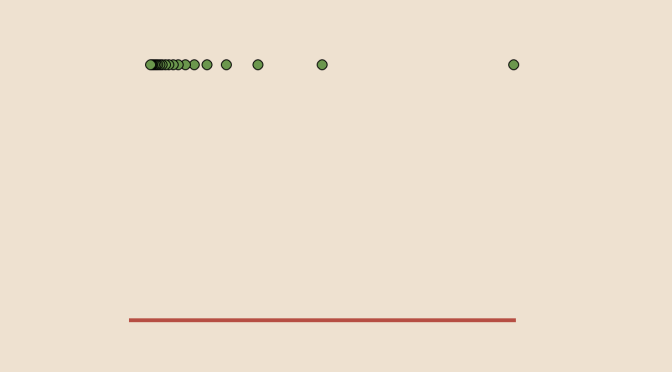Let \(f\) and \(g\) be two real functions and \(a \in \mathbb R \cup \{+\infty\}\). We provide here examples and counterexamples regarding the limits of \(f\) and \(g\).
If \(f\) has a limit as \(x\) tends to \(a\) then \(\vert f \vert\) also?
This is true. It is a consequence of the reverse triangle inequality \[\left\vert \vert f(x) \vert – \vert l \vert \right\vert \le \vert f(x) – l \vert\] Hence if \(\displaystyle \lim\limits_{x \to a} f(x) = l\), \(\displaystyle \lim\limits_{x \to a} \vert f(x) \vert = \vert l \vert\)
Is the converse of previous statement also true?
It is not. Consider the function defined by: \[\begin{array}{l|rcl}
f : & \mathbb R & \longrightarrow & \mathbb R \\
& \frac{1}{n} & \longmapsto & -1 \text{ for } n \ge 1 \text{ integer} \\
& x & \longmapsto & 1 \text{ otherwise} \end{array}\] \(\vert f \vert\) is the constant function equal to \(1\), hence \(\vert f \vert\) has \(1\) for limit as \(x\) tends to zero. However \(\lim\limits_{x \to 0} f(x)\) doesn’t exist.
If \(f\) has a limit at \(a\) and \(g\) not, then \(f+g\) doesn’t have a limit at \(a\)?
This is a tricky question! The case where \(\displaystyle \lim\limits_{x \to a} f(x) = l\) is finite is covered in the next paragraph. If \(l\) is infinite, \(f+g\) can have a limit at \(a\). Consider \[\begin{array}{l|rcl}
g : & (0,1) & \longrightarrow & \mathbb R \\
& x & \longmapsto & \sin \frac{1}{x} \end{array}\] and \[\begin{array}{l|rcl}
f : & (0,1) & \longrightarrow & \mathbb R \\
& x & \longmapsto & \frac{1}{x} \end{array}\] We have \(\displaystyle \lim\limits_{x \to 0^+} f(x)=+\infty\), \(g\) doesn’t have a right limit at \(0\) but \(\displaystyle \lim\limits_{x \to 0^+} (f+g)(x)=+\infty\)
If \(f\) has a finite limit at \(a\) and \(g\) not, then \(f+g\) doesn’t have a finite limit at \(a\)?
This is true. If \(f+g\) was having a finite limit at \(a\), writing \(g=(f+g)-f\) we see that \(g\) would have a limit as the difference of two functions having a limit at a point has a limit at that point. In contradiction with our hypothesis.
If \(f\) is defined on (u,v) and monotonic, then \(f\) has left and right limits at all \(a \in (u,v)\)?
This is true. Suppose that \(f\) is increasing (if \(f\) is decreasing, just consider \(-f\)). We prove that \(f\) has a left limit for all \(a \in (u,v)\), the proof being similar for the right limit. Consider the set \(S=\{f(x) | x < a\}\). \(S\) is bounded by \(f(a)\) and not empty as \(f(\frac{u+a}{2}) \in S\). Therefore \(S\) has a least upper bound \(l\). For any \(\epsilon > 0\), there exists \(y < a\) with \(l - \epsilon \le f(y) \le l\). As \(f\) is increasing we have for \(y < x < a\) \[f-\epsilon \le f(y) \le f(x) \le l\] proving that \(\displaystyle \lim\limits_{x \to a^-} f(x) = l\).
If \(f\) has finite left and right limits for all \(a \in [u,v]\) then \(f\) is bounded on \([u,v]\)?
This is true. Suppose that \((a_n)\) is a sequence of \([u,v]\) with \((f(a_n))\) unbounded. As \([u,v]\) is compact one can find a converging subsequence \((a_{\alpha_n})\) converging to \(a \in [u,v]\) with \((f(a_{\alpha_n}))\) unbounded. Then either an infinite number of elements of \((a_{\alpha_n})\) are less than \(a\) and \(f\) cannot have a finite left limit at \(a\) or an infinite number of elements of \((a_{\alpha_n})\) are larger than \(a\) and \(f\) cannot have a finite right limit at \(a\). In both cases we get a contradiction, hence \(f\) is bounded on \([u,v]\).
What about the reverse of previous statement?
It is false. Consider the Dirichlet function \[\begin{array}{l|rcl}
f : & \mathbb R & \longrightarrow & \mathbb R \\
& x & \longmapsto & 1 \text{ for } x \in \mathbb Q \\
& x & \longmapsto & 0 \text{ for } x \in \mathbb R \setminus \mathbb Q \end{array}\] \(f\) is bounded but doesn’t have a limit at any \(a \in \mathbb R\) as \(\mathbb Q\) is dense in \([0,1]\).
A real function \(f\) has a limit at least one point \(a \in \mathbb R\)?
Is wrong. Consider again Dirichlet function of previous paragraph.
A function continuous at \(a\) is continuous on an interval containing \(a\)?
Doesn’t hold. Consider \[\begin{array}{l|rcl}
f : & \mathbb R & \longrightarrow & \mathbb R \\
& x & \longmapsto & \vert x \vert \text{ for } x \in \mathbb Q \\
& x & \longmapsto & 0 \text{ for } x \in \mathbb R \setminus \mathbb Q \end{array}\] \(f\) is continuous at \(0\) as we have \(\vert f(x) \vert \le \vert x \vert\) for all \(x \in \mathbb R\).
However for \(a \neq 0\) \(f\) is not continuous at \(a\) as:
- if \(a \in \mathbb Q\), we have \(f(a) > 0\) and \(f(x_n)=0\) for a sequence \((x_n)\) of irrational points converging to \(a\).
- if \(a \in \mathbb R \setminus \mathbb Q\), we have \(f(a) = 0\) and \(f(x_n) \to \vert a \vert\ > 0\) for a sequence \((x_n)\) of rational points converging to \(a\).
There exists at least an interval \((u,v)\) on which \(f\) is bounded?
Is wrong. Have a look to a nowhere locally bounded function.

